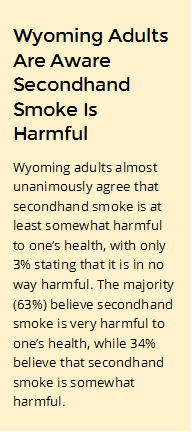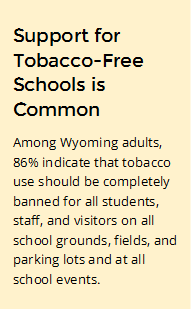 Goal Area 1: Preventing Initiation of Tobacco Use
Goal Area 1: Preventing Initiation of Tobacco Use
The Wyoming Tobacco Prevention and Control Program and the CDC share the goal of reducing the health burdens of tobacco use by preventing its initiation.
Age of Smoking a Whole Cigarette for the First Time
The majority of those who have ever smoked a whole cigarette smoked their first whole cigarette when they were younger than 18. However, there was still a large group who smoked a whole cigarette for the first time between the ages of 18 and 24 (Figure 6).
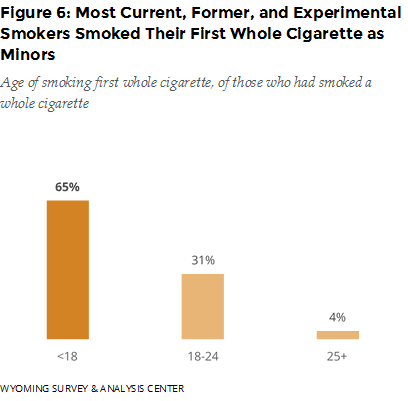 Age of Initiating Daily Smoking
Age of Initiating Daily Smoking
Among daily smokers or smokers who at one time had been daily smokers (at least one cigarette per day for 30 days in a row), 90% said they started smoking daily when younger than 25. The percentage of those who started smoking daily when under the age of 18 has significantly declined since 2010. Meanwhile, the percentage of those who started smoking daily at 25 or older significantly increased over the same time period. The percentage of young adults (18–24) who started smoking daily did not change significantly between 2010 and 2015 (Figure 7).
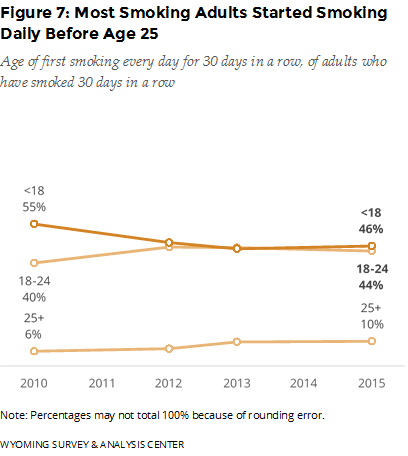 Conclusions
Conclusions
The smoking habits of the vast majority of Wyoming adults begin when they are under the age of 25. After age 25, very few adults begin to smoke or begin to smoke daily, though the age at which smokers initiate daily smoking appears to be increasing.
Goal Area 2: Eliminating Nonsmokers’ Exposure to Secondhand Smoke
The Wyoming Tobacco Prevention and Control Program and the CDC share the goal of reducing the health burdens of tobacco use by eliminating nonsmokers’ exposure to secondhand smoke.
Support for Indoor Smokefree Policies and Laws
The 2015 ATS asked questions about both smokefree indoor air policies and smokefree indoor air laws. The policy questions asked respondents if they think smoking should be allowed indoors at workplaces, restaurants, bars, and casinos and clubs. (Casinos and clubs were asked as a single survey item, so WYSAC treated them as a single venue type.) The survey questions about smokefree laws asked respondents if they support or oppose statewide smokefree indoor air laws in Wyoming for all workplaces, restaurants, bars, and casinos and clubs. Results from the policy questions revealed that the percentage of Wyomingites who agreed that smoking indoors should never be allowed in workplaces or restaurants significantly increased from 2002 to 2015. For bars and casinos and clubs, more Wyoming adults believed that smoking should never be allowed indoors in 2015 than in 2013, but support for smokefree policies in these three venues was still lower than other venues (Figure 8).
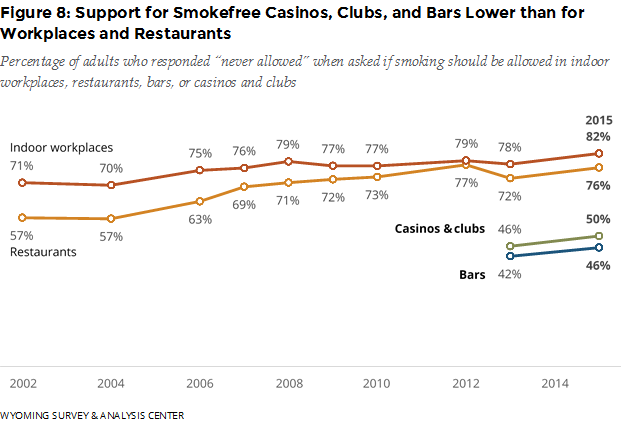
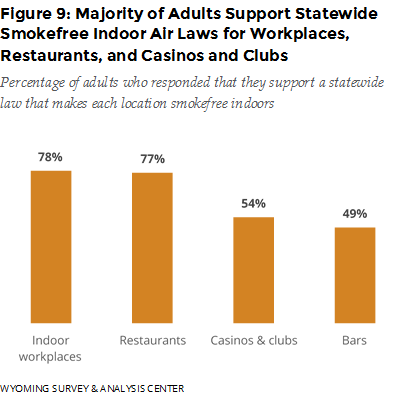
The majority of Wyoming adults supported statewide smokefree indoor air laws covering all workplaces, restaurants, or casinos and clubs. About half (49%) supported a statewide smokefree indoor air law covering all bars (Figure 9).
WYSAC performed logistic regression analyses to identify associations between support for a state smokefree indoor air law for each venue and seven demographic variables: age, gender, annual household income, education, race, ethnicity, and sexual orientation. WYSAC modeled each of the four venues in Figure 9 separately, using these seven demographic variables as predictors. When controlling for the other demographic variables, gender, income, and education were significantly associated with support for legally protected smokefree indoor air for workplaces, restaurants, bars, and casinos and clubs. Men were less likely to support smokefree indoor air laws than women. Adults with income less than $30,000 and adults with a high school diploma, GED, or less education were relatively unlikely to support smokefree indoor air laws (Table 1). See Appendix C for detailed results.
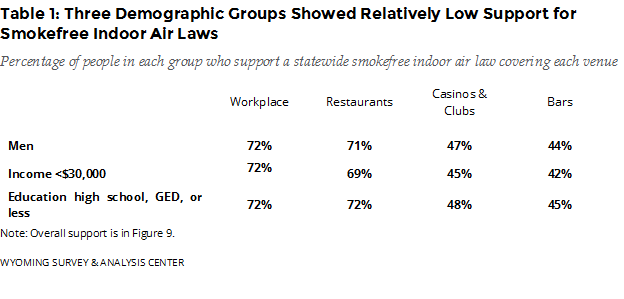
Support for Outdoor Smokefree Policies and Laws
In 2015, most Wyomingites (82%) agreed that smoking should be restricted at outdoor parks: 44% of adults agreed that smoking should be allowed only at some times or in some places; 38% agreed that smoking should never be allowed. These proportions have not significantly changed since 2010.
Support for laws making outdoor workplaces smokefree was substantially lower than support for laws making indoor workplaces smokefree: 65% of Wyoming adults opposed a state smokefree air law for all outdoor workplaces while only 28% would support such a law; 8% said they were unsure.
Exposure to Secondhand Smoke
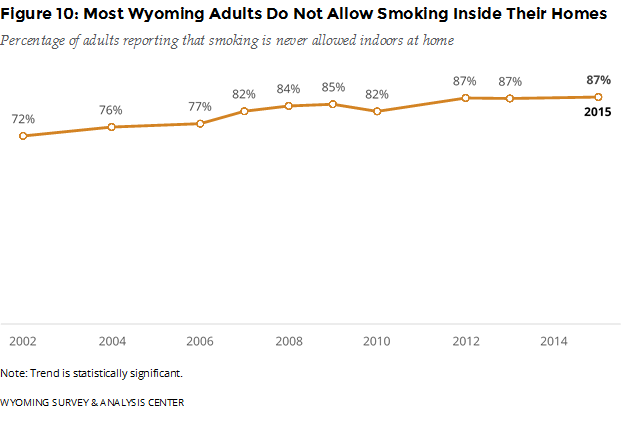
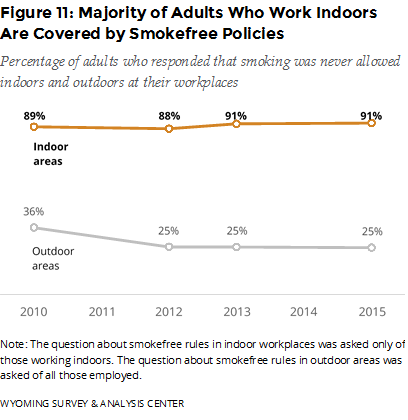 The percentage of Wyoming adults who reported they do not allow smoking inside their homes has increased significantly over time (Figure 10).
The percentage of Wyoming adults who reported they do not allow smoking inside their homes has increased significantly over time (Figure 10).
Most Wyoming adults (91%) who worked indoors reported that smoking was never allowed in indoor areas (including inside a vehicle) at their place of work. Conversely, relatively few (including those who worked outside) reported that smoking was not allowed in outdoor areas (Figure 11).
Most adults were not regularly exposed to secondhand smoke at their place of work; 78% reported that they had not breathed someone else’s smoke at their workplace in the previous seven days. However, 91% stated that their indoor workplace had smokefree policies, indicating that some Wyoming adults reported exposure to secondhand smoke despite those policies.
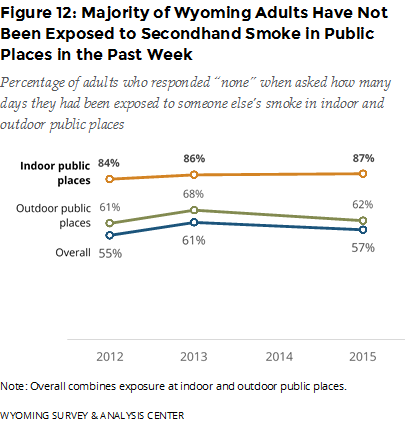 Relatively few Wyoming adults reported being exposed to secondhand smoke while at indoor or outdoor public places in the past seven days (Figure 12).
Relatively few Wyoming adults reported being exposed to secondhand smoke while at indoor or outdoor public places in the past seven days (Figure 12).
Conclusions
Opinions vary as to where and how smoking should be restricted. Wyoming adults have a high degree of agreement that indoor areas of restaurants and workplaces across the state should have smokefree indoor air. There is less agreement on smokefree air policies and laws for casinos, clubs, bars, and outdoor work areas. Most adults report working in places that have smokefree indoor air policies, but outdoor smokefree air policies at workplaces are rare. Most exposure to secondhand smoke occurs in outdoor areas, including at work and public places.

